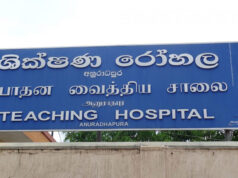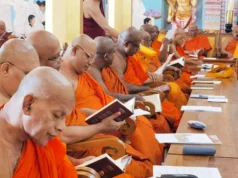A new play that combines two great pillars of literature – the Mah?bh?ratha and Antigone – with the untold histories of the Sri Lankan civil war to forge a new story about surviving loss, discovering love and building a path to justice, by Lankan origin Australian writer and director S. Shakthidharan and Eamon Flack is a soaring achievement, says The Guardian.
The play staged at Belvoir St theatre, Sydney shows people living and loving despite danger, says a report by TG.It says: Ablindfolded woman, wearing a sari, places a conch shell on the ground. It might serve as a ritualistic trumpet or a reminder of a Sri Lankan beach towards the end of the country’s 26-year civil war – when tens of thousands of bodies lay scattered on its sand as though they had fallen from the sky.
She then dances slowly, sorrowfully, with precise mime and hand gestures to signal her pain. We soon learn this matriarch, Gowrie, had taken a vow many years earlier to wear the blindfold until her four children could be reunited, after her only son was swept away with the Tamil Tigers – a group the Sinhalese-controlled government branded terrorists.
In this silent, impactful opening scene of The Jungle and the Sea, Anandavalli – in her first acting role – brings to Gowrie her own experience: first, as artistic director of the Lingalayam Dance Company, notably in the classical Indian dance form bharata natyam; and also as a survivor of trauma herself.
Co-written and co-directed by Anandavalli’s playwright son S Shakthidharan with Belvoir’s artistic director Eamon Flack, the play is a companion piece to 2019 epic Counting and Cracking, which aimed to fill the silences between first- and second-generation Sri Lankan-Australian refugees about their shared history. It went on to win seven Helpmann awards, and recently toured to Edinburgh and Birmingham.
During the long development process for Counting and Cracking, Anandavalli gradually opened up to her son about fleeing Sri Lanka for Australia, and agreed to act in this latest work. It features seven other actors plus two musicians playing carnatic instruments including the lute-like saraswati veena, and percussion such as a mridangam and a ghatam clay pot.
Like its predecessor, The Jungle and the Sea is another achievement of sustained feeling and empathy, of insight into chaos, power and the human instinct for joy and survival. This is all the more remarkable given the simplicity of the production, with a revolving stage used at different speeds to indicate travel between eras and locations, and little reliance on props. There is no scenery apart from bullet holes running the width of the theatre walls.
While Shakthidharan and Flack’s earlier play charted the origins of the conflict and was set mainly in the capital of Colombo on the west coast, The Jungle and the Sea shifts the focus to northern Sri Lanka, where the violence was concentrated. It is focused on 1995, the war’s final year of 2009, and the present day in 2022.
Shakthidharan shows people living and loving despite danger and death – but this new material carries risk. While Counting and Cracking aimed to help Sri Lankans heal and feel a part of the Australian story, and endeavoured to provide a space for many truths across religious and ethnic lines, there is potential for retraumatisation from the violent events recounted in The Jungle and the Sea.
Perhaps this is why that violence is portrayed stylistically, with characters smearing their faces with blood to denote death and then walking away – a too-subtle strategy which dramatically undersells a couple of moments. A wedding across religious lines during bombing and shelling also risks minimising the horrors of war, although Shakthidharan succeeds in his clear intent to “drive an arrow” through media images of “helpless brown people”, and instead show Sri Lankans “surviving and loving and living”. There are also a couple of repetitive spots in the second act that could do with a trim, particularly around the family’s journey to find the brother, Ahilan (Biman Wimalaratne).
But performances are finely honed. Bollywood actor Prakash Belawadi, who played the patriarch in Counting and Cracking, returns to play the father, Siva, who is poignantly convincing when blinded in the war, and amusing in his reaction when his youngest daughter Lakshmi (Emma Harvie) comes out as a “lesbian atheist” during a well-calibrated comic scene at an expensive Sydney restaurant.
Nadie Kammallaweera, who was also in Counting and Cracking, segues neatly between the widely varying ages of her two characters, daughter Madlu and eccentric but wise Devla. And Kalieaswari Srinivasan plays firebrand daughter Abi with gusto, marrying across sides a Sinhalese groom, Himal (Rajan Velu), then trying to light a funeral pyre for her sibling, risking the wrath of the state in a denouement reminiscent of Antigone’s defiance.
The play will prompt important conversations about the Sri Lankan government killing its own citizens during the war, turning heavy machinery upon them or encouraging them to take shelter at church or hospital before bombing such gathering places.
Wise words translated to English from devotional Tamil poetry ultimately take centre stage with appeals to our better selves, even as war sloganeering twists language and we are reminded love itself can be “abused, betrayed, sensationalised”. The final dance is saved for the matriarch Gowrie, whom poetic licence gifts the sight of her children once again, as fretted strings and double-barreled drums play out.The Jungle and the Sea is at Belvoir Street theatre until 18 December.







